
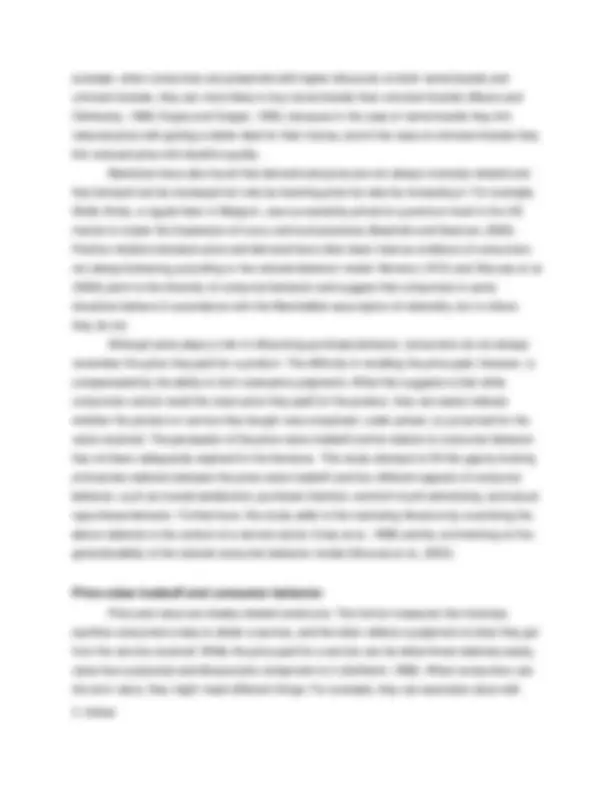
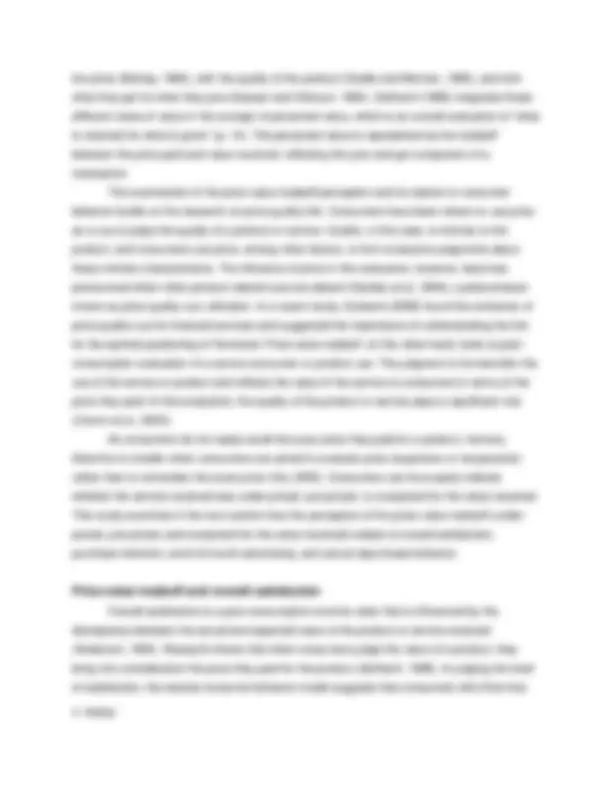
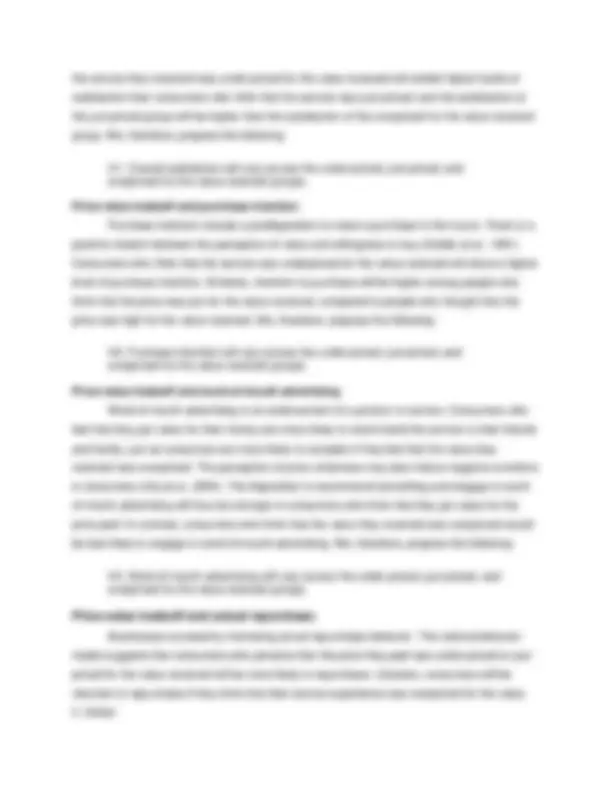
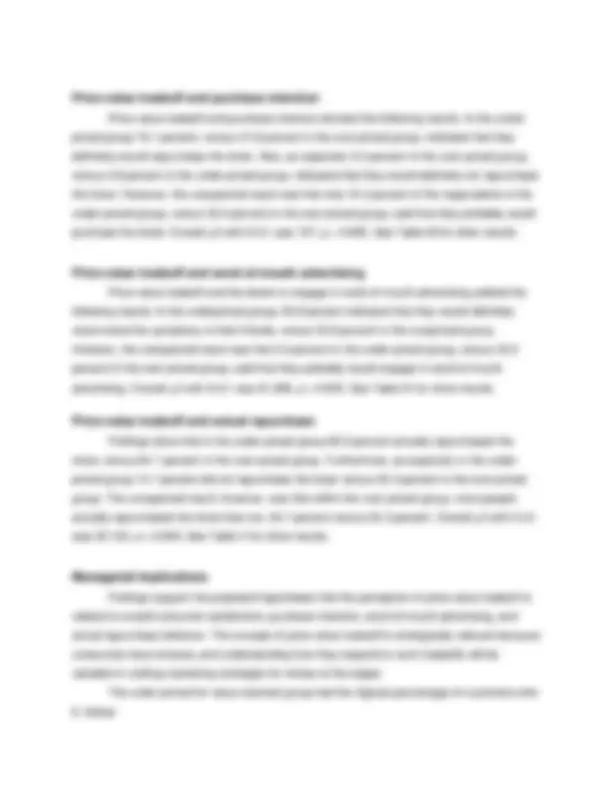
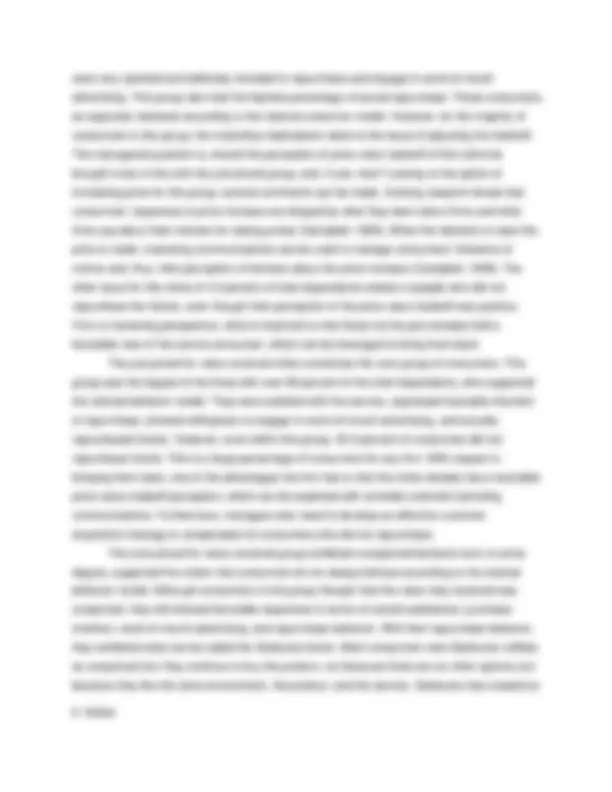
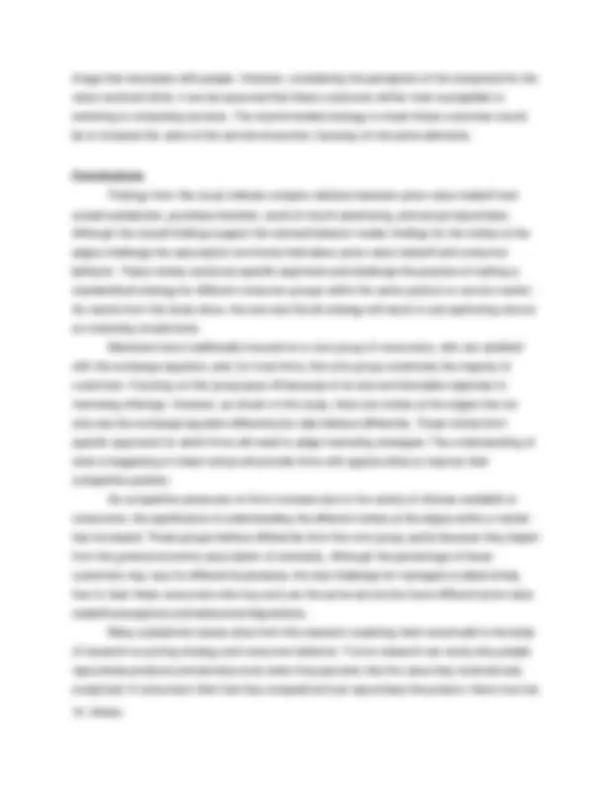

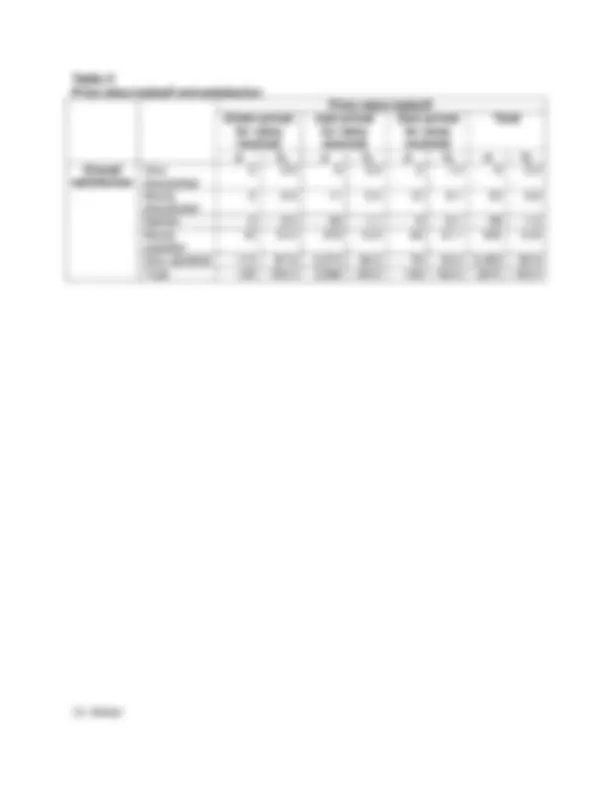



Study with the several resources on Docsity

Earn points by helping other students or get them with a premium plan


Prepare for your exams
Study with the several resources on Docsity

Earn points to download
Earn points by helping other students or get them with a premium plan
Community
Ask the community for help and clear up your study doubts
Discover the best universities in your country according to Docsity users
Free resources
Download our free guides on studying techniques, anxiety management strategies, and thesis advice from Docsity tutors
The relationship between consumers' perception of price-value tradeoff and their overall satisfaction, purchase intention, word-of-mouth advertising, and actual repurchase behavior. The study, conducted by Syed H. Akhter from Marquette University, also discusses the implications for marketing strategies and the limitations of the research.
Typology: Lecture notes
1 / 17

This page cannot be seen from the preview
Don't miss anything!










Purpose – The purpose of this paper is to examine how the perception of price-value tradeoff is related to overall satisfaction, purchase intention, word-of-mouth advertising, and actual repurchase behavior. Design/methodology/approach – Data on subscribers and single ticket buyers of a major symphony orchestra in the Midwest are used to test the hypotheses. Findings – The ANOVA results show significant differences across the three levels of price- value tradeoff in each of the response variables. Additional analyses of cross-tabulated data show that some of the bivariate relations conform to, as well as depart from, the rational consumer behavior model. Research limitations/implications – Although the hypotheses are supported, bivariate relations examined in this study can mask or overstate true relations due to the omitted variables bias. Future research can explore reasons for favorable behaviors of consumers whose perception is that the value they receive is overpriced, and also for unfavorable behaviors of consumers whose perception is that the value they received is under-priced. Practical implications – The different niches at the edges provide opportunities for marketers to fine-tune segmentation and marketing mix strategies. The use of standardized strategies for these niches with different perception and behavior linkages will yield suboptimal results. Originality/value – While previous research has mostly focused on price-quality linkages, this study extends the body of research by examining the perception of price-value tradeoff and its relation to overall satisfaction, purchase intention, word-of-mouth advertising, and actual repurchase behavior. This adds to our understanding of post consumption behavior, showing how consumers respond to the perception of price-value tradeoff.
Although the theoretical significance of scholarly research in marketing is well established in the academia, marketing executives sometimes feel that the elaborate conceptual linkages presented in academic studies fail to provide meaningful guidance in strategic decision making. Managers also express difficulty in relating findings from these studies to routine consumer behavior and thus shy away from using them. McCole (2004) points to this situation
and suggests that there exists a sizable gap between the worldviews of academics and practitioners. And Brennen (2004, p. 492), in his editorial comments in a special issue that explored the nature of the academic-practitioner divide, notes that “a consensus seems to be emerging that much, or perhaps most, of work done by academics is of limited relevance to practitioners.” These concerns have spilled into the academia where marketing and management scholars continue to debate the tradeoffs between rigor and relevance of academic research. The debate continues, and the issue of how to select research questions as well as how to answer them is far from resolved. But there has emerged a new orientation in the discipline that focuses more on discovering parsimonious relations between constructs than on developing grand models of consumer behavior. Major scholarly journals have also taken the lead in requiring authors to delineate the strategic implications of the findings of their research. Changes are also evident in the corporate world, where access to large data bases has led to data mining and data-based marketing strategies and has motivated the search for customer segments whose needs and wants can be satisfied with differentiated value propositions. In light of the above considerations, this paper takes a more applied approach to examining relations between the perception of price-value tradeoff and four aspects of consumer behavior, overall satisfaction, purchase intention, word-of-mouth advertising, and actual repurchase behavior. With respect to these bivariate relations, the paper also comments on the rational consumer behavior model and discusses the strategic implications of the findings. The underlying premise of this paper is that the delineations of bivariate relations can reveal meaningful insights that can prove strategically valuable for segmenting markets, especially at the edges, and developing value enhancing offerings. The proposed relations are tested on data collected by a symphony orchestra in a large Midwestern city.
As one of the marketing mix variables, price plays an important role in influencing consumers’ perception of products, increasing demand, attracting customers, and promoting brand loyalty, among other things. Research in marketing shows that the perception of reference price (price considered reasonable or fair by consumers) can be altered by changing how price is presented to consumers (Morris and Morris, 1990; Simonson and Tversky, 1992). If, for example, a higher priced product is added to the top of the product line, buyers’ reference price increases. Research also shows that consumers respond differently to price discounts. For
low price (Bishop, 1984), with the quality of the product (Dodds and Monroe, 1985), and with what they get for what they give (Sawyer and Dickson, 1984). Zeithaml (1988) integrates these different views of value in the concept of perceived value, which is an overall evaluation of “what is received for what is given” (p. 14). The perceived value is represented as the tradeoff between the price paid and value received, reflecting the give and get component of a transaction. The examination of the price-value tradeoff perception and its relation to consumer behavior builds on the research on price-quality link. Consumers have been shown to use price as a cue to judge the quality of a product or service. Quality, in this case, is intrinsic to the product, and consumers use price, among other factors, to form evaluative judgments about these intrinsic characteristics. The influence of price in this evaluation, however, becomes pronounced when other product-related cues are absent (Kardes et al ., 2004), a phenomenon known as price-quality cue utilization. In a recent study, Estelami (2008) found the existence of price-quality cue for financial services and suggested the importance of understanding the link for the optimal positioning of the brand. Price-value tradeoff, on the other hand, looks at post- consumption evaluation of a service encounter or product use. The judgment is formed after the use of the service or product and reflects the value of the service to consumers in terms of the price they paid. In this evaluation, the quality of the product or service plays a significant role (Cronin et al ., 2000). As consumers do not easily recall the exact price they paid for a product, memory distortion is smaller when consumers are asked to evaluate price (expensive or inexpensive) rather than to remember the exact price (Xia, 2005). Consumers can thus easily indicate whether the service received was under-priced, just-priced, or overpriced for the value received. This study examines in the next section how the perception of the price-value tradeoff (under- priced, just-priced, and overpriced for the value received) relates to overall satisfaction, purchase intention, word-of-mouth advertising, and actual repurchase behavior.
Overall satisfaction is a post-consumption emotive state that is influenced by the discrepancy between the actual and expected value of the product or service received (Anderson, 1994). Research shows that when consumers judge the value of a product, they bring into consideration the price they paid for the product (Zeithaml, 1988). In judging the level of satisfaction, the rational consumer behavior model suggests that consumers who think that
the service they received was under-priced for the value received will exhibit higher levels of satisfaction than consumers who think that the service was just-priced; and the satisfaction of the just-priced group will be higher than the satisfaction of the overpriced for the value received group. We, therefore, propose the following:
H1. Overall satisfaction will vary across the under-priced, just-priced, and overpriced for the value received groups.
Price-value tradeoff and purchase intention Purchase intention reveals a predisposition to make a purchase in the future. There is a positive relation between the perception of value and willingness to buy (Dodds et al ., 1991). Consumers who think that the service was underpriced for the value received will show a higher level of purchase intention. Similarly, intention to purchase will be higher among people who think that the price was just for the value received, compared to people who thought that the price was high for the value received. We, therefore, propose the following:
H2. Purchase intention will vary across the under-priced, just-priced, and overpriced for the value received groups.
Price-value tradeoff and word-of-mouth advertising Word-of-mouth advertising is an endorsement of a product or service. Consumers who feel that they got value for their money are more likely to recommend the service to their friends and family, just as consumers are more likely to complain if they feel that the value they received was overpriced. The perception of price unfairness may also induce negative emotions in consumers (Xia et al ., 2004). The disposition to recommend something and engage in word- of-mouth advertising will thus be stronger in consumers who think that they got value for the price paid. In contrast, consumers who think that the value they received was overpriced would be less likely to engage in word-of-mouth advertising. We, therefore, propose the following:
H3. Word-of-mouth advertising will vary across the under-priced, just-priced, and overpriced for the value received groups.
Businesses succeed by motivating actual repurchase behavior. The rational behavior model suggests that consumers who perceive that the price they paid was under-priced or just- priced for the value received will be more likely to repurchase. Likewise, consumers will be reluctant to repurchase if they think that their service experience was overpriced for the value
point Likert scale, ranging from definitely will not, probably not, might or might not, probably will, and definitely will. Data on word-of-mouth advertising was obtained by asking respondents to indicate how likely they were to recommend the symphony to people they know on a five-point Likert scale, ranging from definitely would not, probably would not, might or might not, probably would, and definitely would. Actual repurchase was recorded by registering whether or not the respondents actually repurchased symphony tickets.
Results We first present the ANOVA results. Following this, we discuss the findings from cross- tabulations. For both analyses, a pairwise deletion procedure was followed. The ANOVA results show significant differences in means in each of the four aspects of consumer behavior – overall satisfaction, purchase intention, word-of-mouth advertising, and actual repurchase behavior (see Table I). For overall satisfaction (F = 83:790, df = 2; 2972, p-value = 0:000), for purchase intention (F = 42.413, df = 2; 2977, p-value = 0:000), for word-of-mouth advertising (F = 30:382, df = 2; 2967, p-value = 0:000), and for actual repurchase (F = 11:148, df = 2; 2999, p-value = 0:000). While the results above support the hypotheses presented in the paper, more detailed information about consumer behavior can be gleaned from cross-tabulated data. In discussing findings from the cross-tabulations, we first focus on relations at the edges (the under-priced for the value received group and the over-priced for the value received group) and then on relations both within and between the three groups to comment on the rational consumer behavior model. Although the bivariate links presented in this study provide useful insights into one-on- one relations between price-value tradeoff and four different aspects of consumer behavior, two limitations should be noted. First, bivariate relations can mask or overstate true relations due to omitted variables bias. Second, bivariate relations do not show the linkages that connect the variables in a nomological network. With these limitations in mind, we discuss the results.
In the under-priced for the value received group, 87.6 percent were very satisfied versus 53.3 percent in the over-priced for the value received group. However, the unexpected finding was that a lower percentage of people in the under-priced group, 12.4 percent, were in the mostly satisfied category versus 31.1 percent in the over-priced group. Overall ‱2 with 8 d.f. was 188.5; p = 0:000. See Table II for other results.
Price-value tradeoff and purchase intention showed the following results. In the under- priced group 79.1 percent, versus 37.8 percent in the over-priced group, indicated that they definitely would repurchase the ticket. Also, as expected, 9.5 percent in the over-priced group, versus 0.8 percent in the under-priced group, indicated that they would definitely not repurchase the ticket. However, the unexpected result was that only 16.3 percent of the respondents in the under-priced group, versus 32.4 percent in the over-priced group, said that they probably would purchase the ticket. Overall ‱2 with 8 d.f. was 107; p = 0:000. See Table III for other results.
Price-value tradeoff and the desire to engage in word-of-mouth advertising yielded the following results. In the underpriced group, 92.9 percent indicated that they would definitely recommend the symphony to their friends, versus 55.9 percent in the overpriced group. However, the unexpected result was that 5.5 percent in the under-priced group, versus 35. percent in the over-priced group, said that they probably would engage in word-of-mouth advertising. Overall ‱2 with 8 d.f. was 81.006; p = 0:000. See Table IV for other results.
Findings show that in the under-priced group 85.3 percent actually repurchased the ticket, versus 64.7 percent in the over-priced group. Furthermore, as expected, in the under- priced group 14.7 percent did not repurchase the ticket versus 35.3 percent in the over-priced group. The unexpected result, however, was that within the over-priced group, more people actually repurchased the ticket than not, 64.7 percent versus 35.3 percent. Overall ‱2 with 2 d.f. was 22.153; p = 0:000. See Table V for other results.
Findings support the proposed hypotheses that the perception of price-value tradeoff is related to overall consumer satisfaction, purchase intention, word-of-mouth advertising, and actual repurchase behavior. The concept of price-value tradeoff is strategically relevant because consumers have choices, and understanding how they respond to such tradeoffs will be valuable in crafting marketing strategies for niches at the edges. The under-priced for value received group had the highest percentage of customers who
image that resonates with people. However, considering the perception of the overpriced for the value received niche, it can be assumed that these customers will be most susceptible to switching to competing services. The recommended strategy to retain these customers would be to increase the value of the service encounter, focusing on non-price elements.
Findings from this study indicate complex relations between price-value tradeoff and overall satisfaction, purchase intention, word-of-mouth advertising, and actual repurchase. Although the overall findings support the rational behavior model, findings for the niches at the edges challenge the assumption commonly held about price-value tradeoff and consumer behavior. These niches constitute specific segments and challenge the practice of crafting a standardized strategy for different consumer groups within the same product or service market. As results from this study show, the one-size-fits-all strategy will result in sub-optimizing returns on marketing investments. Marketers have traditionally focused on a core group of consumers, who are satisfied with the exchange equation, and, for most firms, this core group constitutes the majority of customers. Focusing on this group pays off because of its size and favorable response to marketing offerings. However, as shown in this study, there are niches at the edges that not only see the exchange equation differently but also behave differently. These niches form specific segments for which firms will need to adapt marketing strategies. The understanding of what is happening in these niches will provide firms with opportunities to improve their competitive position. As competitive pressures on firms increase due to the variety of choices available to consumers, the significance of understanding the different niches at the edges within a market has increased. These groups behave differently from the core group, partly because they depart from the general economic assumption of rationality. Although the percentage of these customers may vary for different businesses, the real challenge for managers is determining how to treat these consumers who buy and use the same service but have different price-value tradeoff perceptions and behavioral dispositions. Many substantive issues arise from this research; exploring them would add to the body of research on pricing strategy and consumer behavior. Future research can study why people repurchase products and services even when they perceive that the value they received was overpriced. If consumers think that they overpaid and yet repurchase the product, there must be
cognitive, emotional, and contextual factors that play a role in influencing this behavior. These factors can be examined in the context of the price-value tradeoff. Another promising area of research is examining how much of price-value tradeoff can be changed for the under-priced for the value received consumers before they decide not to buy the service. Specifically, to what level can the price be raised before the perception of price-value tradeoff affects behavior? What is the price threshold for consumers before it affects their tradeoff evaluation and behavior? Another promising area of research is determining the effects of price-value tradeoff on consumer behavior for different types of products and services, such as necessities versus luxury versus discretionary goods.
Anderson, E.W. (1994), “Cross-category variation in customer satisfaction and retention”, Marketing Letters , Vol. 5 No. 1, pp. 19-30. Beamish, P.W. and Goerzen, A. (2000), The Global Branding of Stella Artois , Ivey Management Services, London. Bishop, W.R. Jr (1984),“Competitive intelligence”, Progressive Grocer , Vol. 63, pp. 19-20. Brennan, R. (2004), “Should we worry about an ‘academic-practitioner divide’ in marketing?”, Marketing Intelligence & Planning , Vol. 22 No. 5, pp. 492-500. Campbell, M.C. (1999), “Perceptions of price unfairness: antecedents and consequences”, Journal of Marketing Research , Vol. 36, May, pp. 187-99. Cronin, J.J., Brady, M.K. and Hult, G.T.M. (2000), “Assessing the effects of quality, value, and customer satisfaction on consumer behavioral intentions in service environments”, Journal of Retailing ,Vol. 76 No. 2, pp. 193-218. Dodds, W.B. and Monroe, K.B. (1985), “The effect of brand and price information on subjective product evaluations”, in Hirschman, E. and Holbrook, M. (Eds), Advances in Consumer Research , Vol. 12, Association for Consumer Research, Provo, UT, pp. 85-90. Dodds, W.B., Monroe, K.B. and Grewal, D. (1991), “Effects of price, brand, and store information on buyers’ product evaluations”, Journal of Marketing Research , Vol. 28 No. 3, pp. 307-19. Estelami, H. (2008), “Consumer use of the price-quality cue in financial services”, Journal of Product & Brand Management , Vol. 17 No. 3, pp. 197-208. Gupta, S. and Cooper, L.G. (1992), “The discounting of discounts and promotion thresholds”, Journal of Consumer Research , Vol. 19 No. 3, pp. 401-12.
F-value Significance Overall satisfaction F(2, 2972) = 83.790 0. Purchase intention F(2, 2977) = 42.413 0. WOM advertising F(2, 2967) = 30.382 0. Repurchase (^) F(2, 2999) = 11.148 0.
Price-value tradeoff and satisfaction Price-value tradeoff Under-priced for value received
Just-priced for value received
Over-priced for value received
Total
n % n % n % n % Overall satisfaction
Very dissatisfied
Mostly dissatisfied
Neither 0 0.0 30 1.1 9 6.1 39 1. Mostly satisfied
Very satisfied 113 87.6 2,273 84.2 79 53.4 2,465 82. Total 129 100.0 2,698 100.0 148 100.0 2975 100.
Price-value tradeoff and word-of-mouth advertising
Price-value tradeoff and actual repurchase